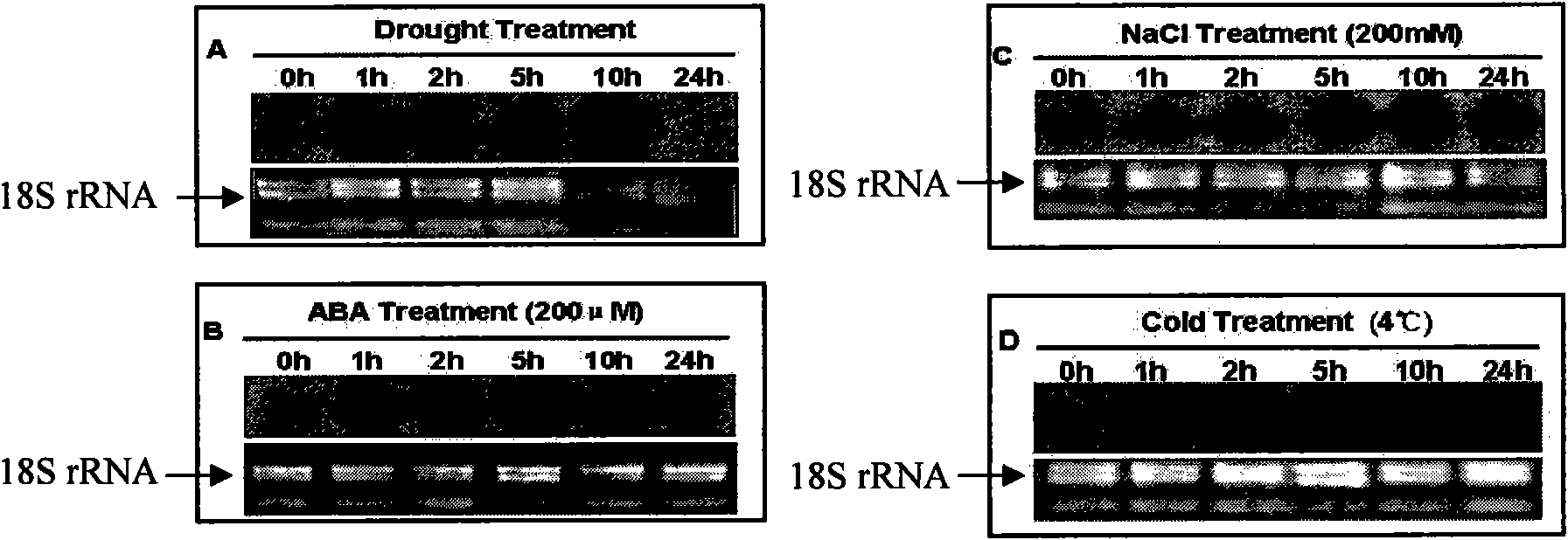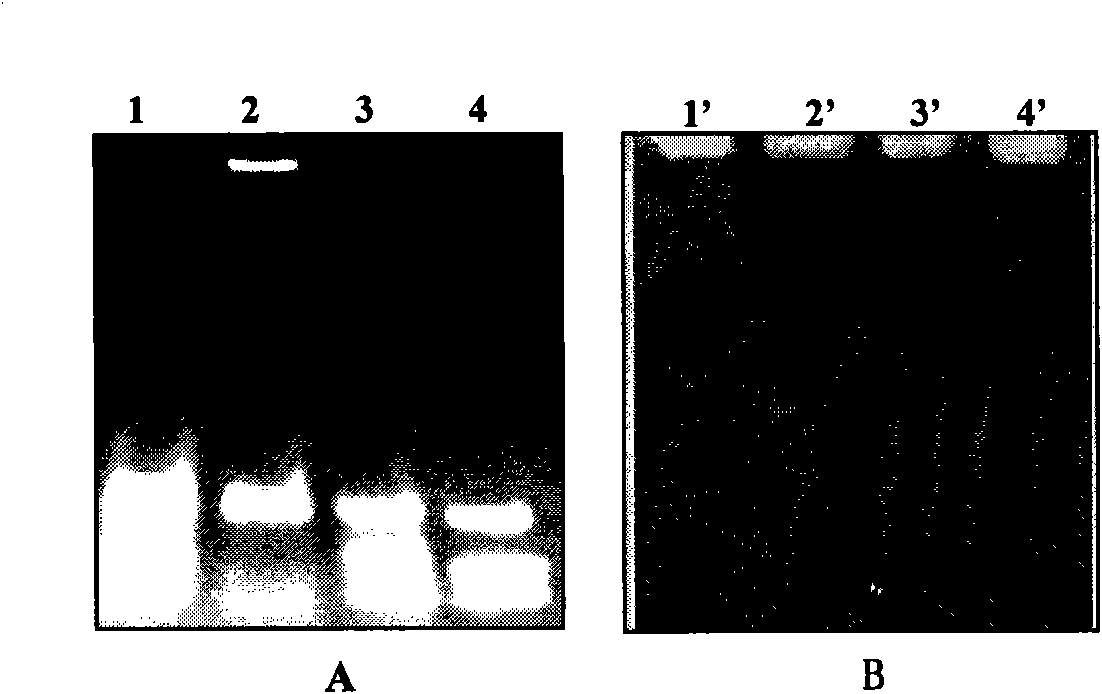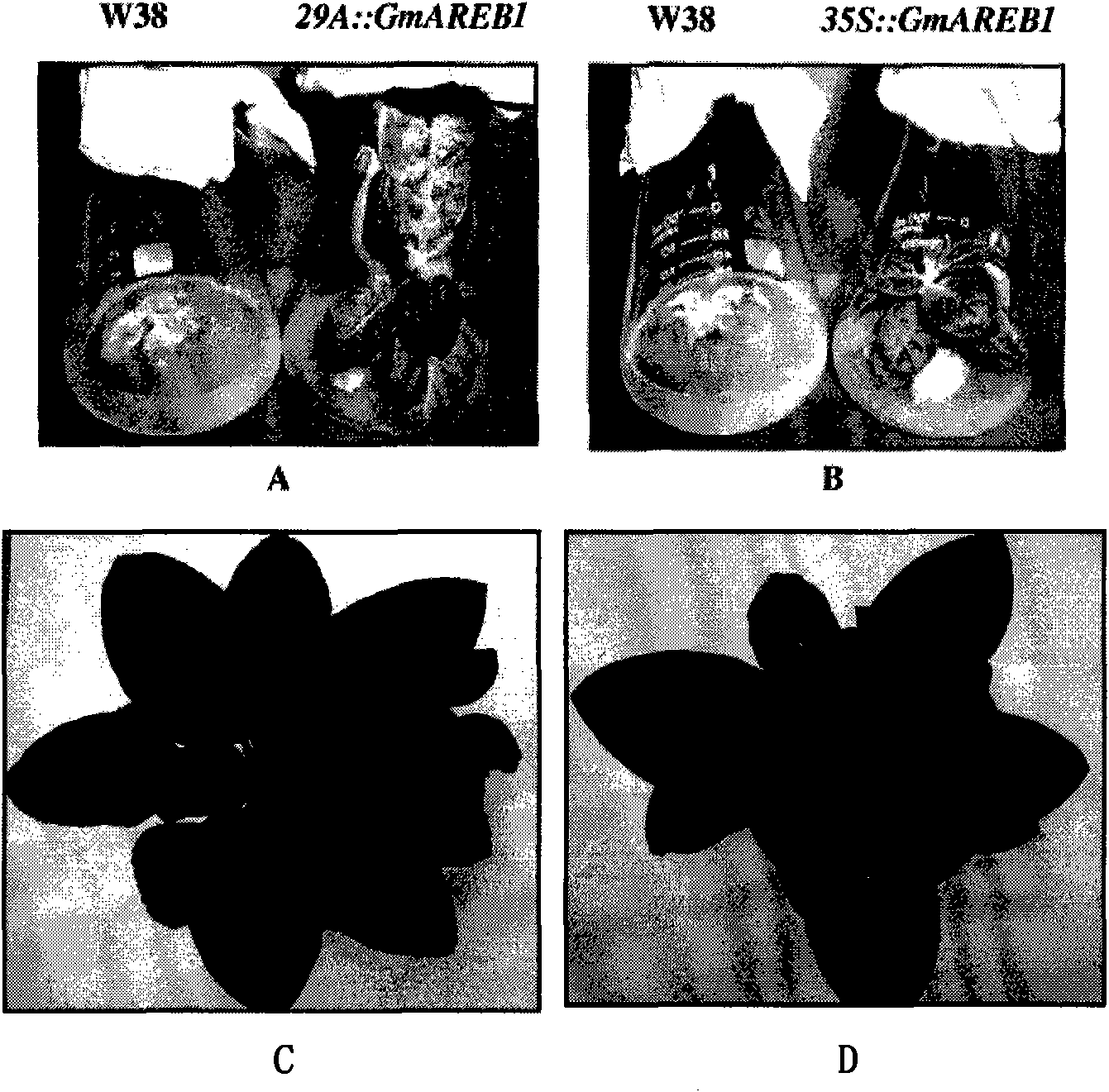Plant stress tolerance correlative protein, coding gene and application thereof
A technology that encodes genes and proteins, which is applied in the fields of plant gene improvement, application, plant peptides, etc., and can solve problems such as small improvement and inability to achieve plant stress resistance
- Summary
- Abstract
- Description
- Claims
- Application Information
AI Technical Summary
Problems solved by technology
Method used
Image
Examples
Embodiment 1
[0047] Example 1. Screening of soybean stress tolerance-related protein GmAREB1 encoding gene and its cDNA clone
[0048] The 14-day-old soybean Tiefeng 8 seedlings (purchased from Yingjun Company) were treated with high salt (200mM NaCl) for 12 hours, and the total RNA of soybean was extracted with Trizol. 5'RACE kit (5'RACE System for Rapid Amplification of cDNA Ends Kit) (GIBCOBRL, CAT.NO.18374-058) and 3'RACE kit (3'RACE System for Rapid Amplification of cDNA Ends Kit) (GIBCOBRL, CAT.NO.18373-019) to obtain the full-length sequence of the GmAREB1 gene.
[0049] The total RNA of soybean Tiefeng 8 seedlings was extracted with Trizol (invitrogen), and cDNA was obtained by reverse transcription with superscriptII (invitrogene) reverse transcriptase. Primers P1 and P2 were designed according to the sequence of the coding region of GmAREB1 gene. Using the cDNA obtained by reverse transcription as a template, PCR amplification was performed with primers P1 and P2. The sequence...
Embodiment 2
[0054] Example 2, Expression characteristics of soybean GmAREB1 gene under adversity stress treatment
[0055] Soybean Tiefeng No. 8 seeds were planted in pots, and after 2 weeks of growth, the seedlings were taken and subjected to the following stress treatments: 1) Drought treatment: the soybean seedlings were taken out from the soil to absorb the moisture on the roots, and placed on dry filter paper; ) salt treatment: soybean seedlings were placed in 200 mM NaCl solution; 3) ABA treatment: soybean seedlings were placed in 200 μM ABA solution; 4) cold treatment: wheat seedlings were placed in a 4 ° C incubator; Samples were taken at 0, 0.5, 1, 3, 6, and 12 hours after various treatments, quickly frozen with liquid nitrogen, and stored at -80°C for later use.
[0056] Total RNA was extracted from samples taken 0, 0.5, 1, 3, 6, and 12 hours after drought treatment, salt treatment, ABA treatment, and cold treatment, and Northern analysis was performed using GmAREB1 DNA as a probe...
Embodiment 3
[0075] Embodiment 3, gel migration or electrophoretic mobility experiment (EMSA)
[0076] 1. Prokaryotic expression of GmAREB1 gene
[0077] The full-length sequence of GmAREB1 gene is inserted in the multiple cloning site of prokaryotic expression vector pGEX-4T-1, because there is GST (glutathione) gene in front of the multiple cloning site of pGEX-4T-1, GmAREB1 and GST protein like this The fusion protein was formed, and the constructed expression vector was transformed into recipient Escherichia coli BL21, and the production of the fusion protein (GmAREB1-GST) was induced by adding inducer IPTG to the medium, and the induced expression of the fusion protein was detected by SDS-PAGE electrophoresis .
[0078] Purify the GmAREB1-GST fusion protein according to the instructions of the MicroSpin GST Purification Module Kit.
[0079] 2. Labeling of ABRE probes
[0080] Synthesize the ABRE probe sequence according to the known sequence, the ABRE probe sequence is as follows: ...
PUM
 Login to View More
Login to View More Abstract
Description
Claims
Application Information
 Login to View More
Login to View More - R&D
- Intellectual Property
- Life Sciences
- Materials
- Tech Scout
- Unparalleled Data Quality
- Higher Quality Content
- 60% Fewer Hallucinations
Browse by: Latest US Patents, China's latest patents, Technical Efficacy Thesaurus, Application Domain, Technology Topic, Popular Technical Reports.
© 2025 PatSnap. All rights reserved.Legal|Privacy policy|Modern Slavery Act Transparency Statement|Sitemap|About US| Contact US: help@patsnap.com



